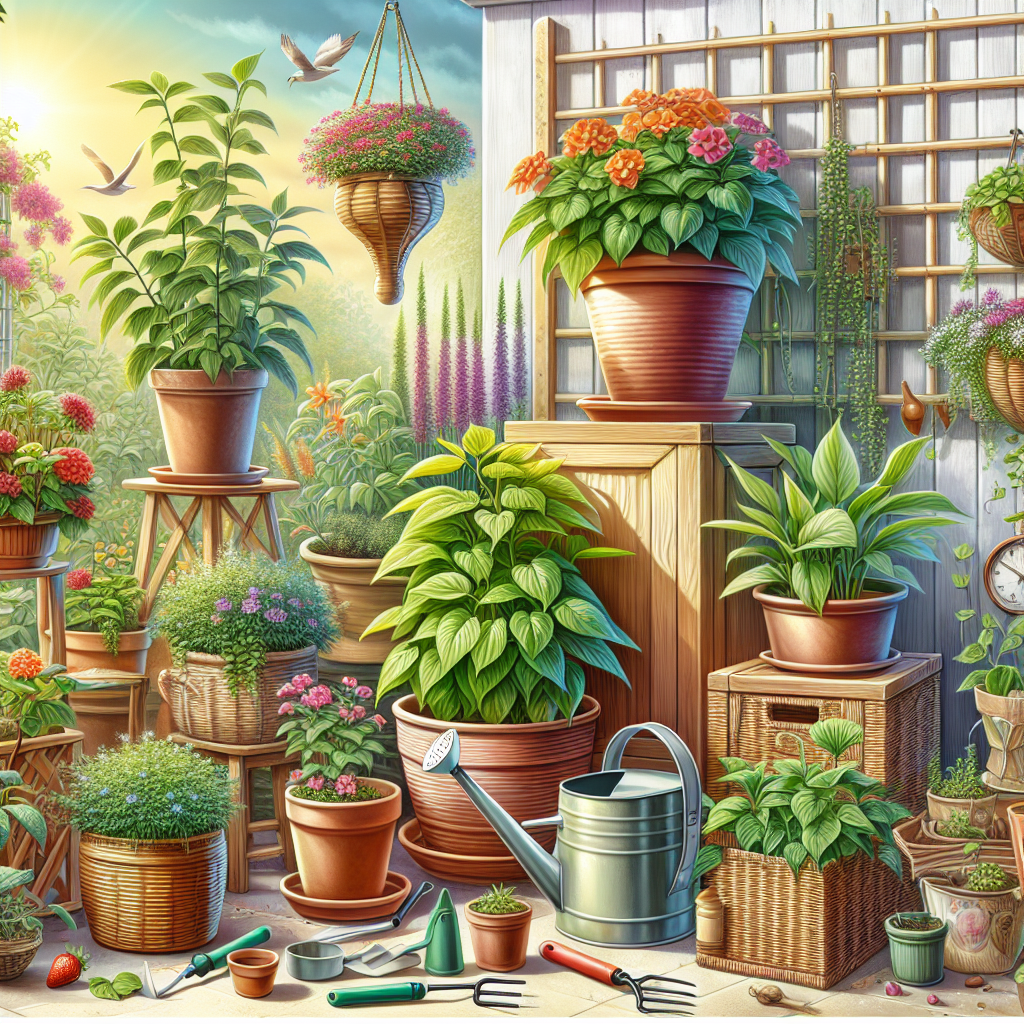Thriving in small spaces: A Guide to Successful container gardening
Introduction
In an era where urban living is prevalent, the luxury of sprawling gardens is often a rare commodity. However, the joy of gardening need not be sacrificed due to limited space. Container gardening offers a versatile, accessible solution for bringing green spaces into small areas, whether they’re balconies, <a href="https://www.enjoycontainergardening.com/blog/2023/10/14/from-patios-to-windowsills-enhancing-your-home-with-container-gardening/” target=”_blank” rel=”noopener noreferrer” class=”redlink”>patios, or even windowsills. This guide will take you through the essential steps and tips to ensure your container garden thrives.
Planning Your Container Garden
Assessing Your Space
Before you begin, evaluate the amount of space you have available and its conditions. Containers can be placed on balconies, rooftops, patios, or windowsills. Measure your area and consider factors like sunlight exposure, wind protection, and access to water.
Choosing the Right Containers
Material Matters: Containers come in a variety of materials including plastic, terracotta, ceramic, wood, and metal. Each has its pros and cons. For instance:
- Plastic containers are lightweight and retain moisture well but can become brittle over time.
- Terracotta pots offer a classic look but can dry out quickly.
- Ceramic containers are aesthetically pleasing but heavy.
- Wooden planters provide excellent insulation for plant roots but may rot if not treated.
Size Considerations: Ensure that containers are appropriately sized for the plants you wish to grow. Larger plants require more space for root growth.
selecting plants
Choose plants according to the conditions of your space:
- sun-loving plants for areas with full sun exposure (6+ hours per day).
- shade-tolerant plants for areas with limited sunlight.
Consider growing a mix of edible plants (herbs, vegetables) and ornamental ones (flowers) based on your preferences.
Planting Essentials
Soil Selection
Opt for high-quality potting mix specifically designed for containers rather than garden soil which might compact easily and hinder root growth. Container soil retains moisture better while ensuring good drainage.
Drainage Concerns
Good drainage is crucial in preventing waterlogged roots which can lead to rot. Ensure each container has sufficient drainage holes at the bottom. Adding a layer of gravel at the base before filling with soil can further enhance drainage.
Watering Strategies
Consistent moisture levels are vital in container gardening since pots dry out faster than ground beds. However, avoid over-watering as it may cause root rot:
- Water deeply until it runs out from the bottom holes.
- In hot weather or with small pots that dry quickly consider using self-watering systems or adding water-retentive crystals into your potting mix.
Fertilizing Tips
Containers rely on regular fertilization since nutrients leach out faster from potting mixes due to frequent watering:
- Use slow-release granular fertilizers mixed into soil during planting.
- Supplement with liquid fertilizers every couple weeks during growing season following instructions provided by product manufacturer tailored towards specific plant needs (vegetables vs flowers).
Seasonal Considerations
Adapt your container garden through different seasons ensuring continuous beauty:
Spring/Summer Planting
In spring focus on getting young seedlings started using early crops followed by summer favorites such as tomatoes peppers herbs etc ensuring they receive enough warmth light through longer days optimize growth potential enjoying fresh produce vibrant blooms peak season ahead!
Fall/Winter Planting
Shift autumnal hues incorporating foliage grasses late-bloomers along hardy perennials transitioning cooler months cover exposed planters protect frost damage employ burlap covers insulating materials reaping winter interest persist snowy days!
Maintenance Practices
Keep eye regular maintenance tasks maintaining healthy flourishing container garden:
1) Pruning Deadheading: Remove spent flowers dead leaves encouraging continued blooming reducing disease risk improving aesthetics overall structure plant!
2) Pest Management: Monitor closely signs pest infestations treating immediately appropriate measures insecticidal soaps neem oils organic remedies promoting eco-friendly balance minimizing harm beneficial insects!
3) Repotting Dividing: As necessary repot divide overcrowded root-bound plants provide refreshed environments encourage vigorous new growth!
Sustainable Practices
Adopt environmentally conscious approaches sustaining green initiatives within compact confines:
1) Recycle Repurpose: Utilize discarded items creative container options old mugs buckets tires reducing waste maximizing resourcefulness!
2) rainwater harvesting: Collect store rainwater employing efficient irrigation systems conserving precious freshwater resources contributing sustainability efforts beyond individual scope larger scale environmental impact!
Conclusion
Container gardening transforms limited spaces inviting nature close nurturing personal sanctuaries brimming life beauty regardless urban settings barriers encountered along way! By carefully considering planning essentials following practical advice shared here embark rewarding journey creating thriving mini paradises today tomorrow enjoy rich harvests lasting memories boundless satisfaction derived cultivating intimate connections earth itself within reach fingertips!













